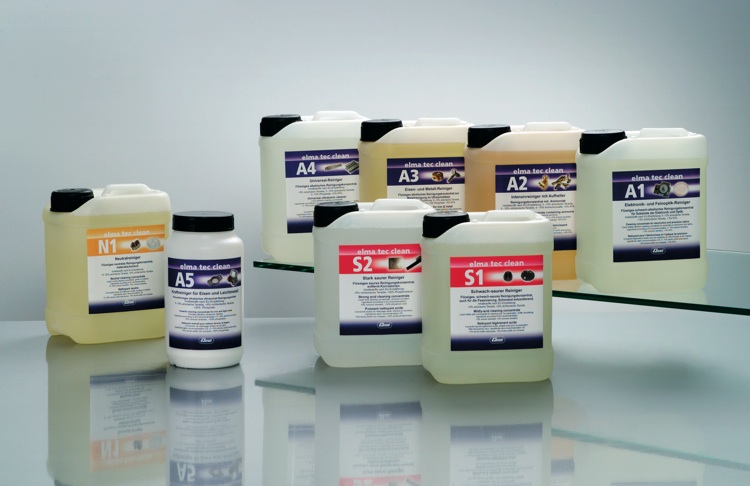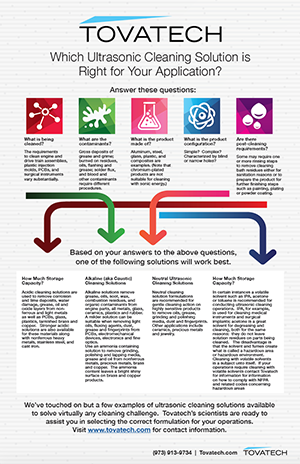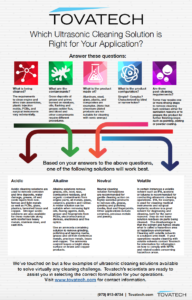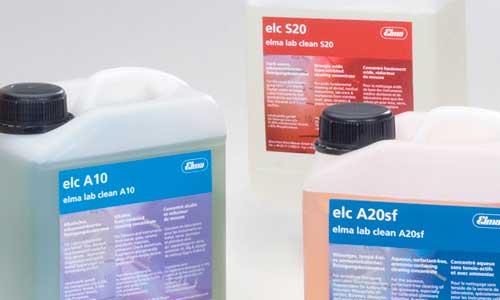
How to Select an Ultrasonic Cleaner Solution
According to Verified Market Research, the Global Ultrasonic Cleaning Solution Market value is estimated to be USD 1,934.90 Million in 2022 and is expected to reach USD 3,211.88 Million by 2030 witnessing a CAGR of around 6.54% during the forecasted period (2024-2030)
Ultrasonic cleaner solutions – also called “soaps” or “chemicals”- are specially formulated to accomplish specific ultrasonic cleaning challenges. Most ultrasonic cleaning solutions are available as concentrates and are biodegradable. These two features contribute to economy and reduce disposal concerns. This post offers tips on how to select your ultrasonic cleaner solution.
How Ultrasonic Cleaner Solutions Work
Regardless of the chemistry, an ultrasonic cleaner solution works by a process called cavitation. But rather than get into a detailed explanation here, please check out our post Ultrasonic Cleaners and How they Work. More info can be found at our ultrasonic cleaner learning center.
What to Know BEFORE Selecting an Ultrasonic Cleaning Solution
What is the Contaminant?
What is the contaminant? Put another way, what do you want to remove with your ultrasonic cleaner solution? Examples include:
- grease, grime and grit on engine and drive train components
- mold support from 3-D printed products
- salt and other residues on scuba gear
- free iron and other contaminants on stainless steel (passivation)
- contaminants on new and reconditioned printed circuit boards
- burned on deposits on plastic injection molds
- finger marks and grime on cherished vinyl LP records
- contaminants on surgical and dental instruments
- oil and residues on finely machined parts
- contaminants on laboratory glassware and instruments
- tarnish or old paint on brass, copper and other surfaces
- powder residues and other contaminants on firearms
What is the Nature of the Contaminant?
Do you want a demulsifying or emulsifying cleaning solution formulation? This distinction deals with what happens to the contaminants, particularly greasy contaminants, as they are removed by the cleaning process.
Demulsifying ultrasonic cleaner solutions cause oily contaminants to float to the surface of the cleaning solution. This makes them easy to skim off either manually or via spray bars and weirs for storage and later disposal.
The step serves two purposes:
- it reduces the potential for floating contaminants to adhere to the product while being removed from the bath.
- it helps prolong the useful life of the ultrasonic cleaning solution. Demulsifying formulations are typically used in high-volume cleaning operations.
Emulsifying cleaning formulations hold contaminants in suspension.
These ultrasonic cleaner solution formulations are used for low-volume cleaning operations.
Because contaminants remain in the solution rather than float to the top they build up over repeated cleaning cycles. In doing so they inhibit cleaning efficiency and, perhaps more important, may remain on the surfaces of cleaned products. This could necessitate post-cleaning rinsing operations.
Hard particles such as chips, fines, shavings and plain old dirt fall to the bottom of the cleaning tank. These must be removed each time the solution is changed, otherwise they can damage the tank bottom. Tank cleaning recommendations are provided in user manuals.
What are you Cleaning?
What is being cleaned? Most anything that can be safely wetted can be cleaned using ultrasonic energy. As a few of many examples, ultrasonic cleaner solution formulations are designed for iron and steel castings, fabricated parts, plastics, precious metals, ceramics, glass, rubber, and polished surfaces such as aluminum.
Is Post-Cleaning Required?
What if any are the steps that follow cleaning?
- nothing – clean and reinstall
- rinsing – may be required to remove solution residues
- total absence of residues – i.e. surgical implants, similar products – is essential
- surface protection – i.e. temporary rust protection
- professional association or government agency recommended steps
Post-Cleaning Points to Consider
Products that are painted, plated or powder coated are prime candidates for thorough post cleaning rinsing to ensure proper adhesion of the coating to the surface.
Post-cleaning rinsing steps can include washing with a water spray and immersion in an ultrasonic rinsing tank. These are used to flush away any residuals remaining due to what is called “drag out.”
In such cases, consider the Elmasonic ST ultrasonic system with the hand-held rinsing option using either tap or demineralized water. There are customized ultrasonic cleaners that can include cleaning and rinsing tanks followed by dryers.
Which brings up yet another point: rust. Since the vast majority of these solutions are water based (and some specifically formulated to remove rust), rust inhibitors should be added either to the solution or to the rinsing tank.
Elma KS, available from Tovatech as a mildly alkaline concentrate, provides temporary corrosion protection on a molecular level.
A Closer Look at Ultrasonic Cleaner Solution Chemistry – What is pH?
What is pH? Wikipedia defines pH as a measure of hydrogen ion concentration; a measure of the acidity or alkalinity of a solution. … Aqueous solutions at 25°C (77⁰F) with a pH less than seven are acidic, while those with a pH greater than seven are basic or alkaline
Although there are exceptions ultrasonic cleaner solutions can be divided into three basic chemistries based on their pH: alkaline, acidic and neutral.
The following paragraphs provide selected examples of cleaning solution chemistries. Ask the Tovatech scientists for recommendations that satisfy your particular requirements.
When to Specify an Acidic Ultrasonic Cleaner Solution
Acidic cleaning solutions are exemplified by elma tec clean S1 with a pH of 1.6 in concentrate form. Recommended dilution is to 1 to 5% with water.
It is used to remove corrosion and lime deposits, water damage, grease, oil and oxide layers from non-ferrous and light metals as well as PCBs, glass, plastics, tarnished brass and copper.
Stronger acidic solutions are also available for these materials along with nonferrous heavy metals, stainless steel, and cast iron. As noted above, surfaces subject to rusting should include elma KS in the cleaning or rinsing tank for temporary corrosion resistance.
An important caution: Stainless steel ultrasonic cleaner solution tanks must be protected when using corrosive low pH solutions such as nitric, sulfuric, formic, or hydrofluoric acid. This is accomplished by using an acid resistant tub (offered in several sizes) along with other precautions described in our post on safely cleaning with acid.
Alkaline Ultrasonic Cleaner Solutions
A highly popular alkaline cleaning solutions is demulsifying elma tec clean A4 with a pH of 13.4. It is widely used in labs and workshops. Diluted to 1 to 5% with water it removes grease, oils, soot, wax, combustion residues, and organic contaminants from engine parts, all metals, glass, ceramics, plastics and rubber.
A slightly milder alkaline formula is emulsifying elma tec clean A1 with a pH of 10.8. Use it for removing light oils, fluxing agents, dust, grease and fingerprints from PCBs, electromechanical devices, electronics and fine optics. Recommended dilutions are to 3 to 10% with water.
Ammonia-containing elma tec clean A2 is an alkaline solution used to remove grinding, polishing and lapping media, grease and oil from nonferrous metals, precious metals, brass and copper. Its ammonia content leaves a bright shiny surface on brass and copper products. With a pH of 11, it is diluted to 5 to 10% with water.
When to Select a Neutral Ultrasonic Cleaner Solution
An example of a neutral cleaning solution is elma tec clean N1 with a pH of 9.3 diluted to 2 to 5% with water.
Neutral cleaning solution formulations are recommended for gentle cleaning action on highly sensitive products to remove oils, grease, grinding and polishing media, dust and fingerprints.
Other applications include ceramics, precious metals and jewelry. (Note that certain gemstones should not be subjected to ultrasound, in which case N1 can be diluted to 10% with tap water and stones slightly swirled in the mixture.)
Another example of a neutral cleaning solution formulation is foam-inhibited elma clean 260 dip & splash that can be used either in an ultrasonic bath diluted to 2%, or for spray cleaning (1%) with tap or deionized water.
This formula is suitable for metallic surfaces including aluminum and light metal alloys as well as for glassy, ceramic and mineral surfaces. It removes aqueous cooling emulsions from mechanical treatments, deposited lime soaps and other contaminants.
Ultrasonic Cleaning using Volatile Solvents
In certain instances a volatile solvent such as IPA, acetone or toluene is recommended for ultrasonic cleaning operations.
IPA, for example, is used for cleaning medical instruments and surgical implants; acetone is a great solvent for degreasing and cleaning, both for the same reasons: they do not leave solution residues on parts being cleaned.
The disadvantage is that the solvent and fumes create what is called a hazardous area or hazardous environment.
Requirements for cleaning with volatile solvents include the use of explosion proof ultrasonic cleaners located in an area where there are no ignition triggers from nearby electrical systems. When operating an explosion-proof ultrasonic cleaner you create what is called a National Electric Code hazardous location due to fumes given off and the possibility of spilled solvent.
If your operations require cleaning with volatile solvents contact Tovatech for information on the SOL-XP explosion-proof ultrasonic cleaner or other options along with information on how to comply with NFPA and related codes concerning hazardous areas. We also invite you to check out our post on cleaning with flammable solvents.
A Wrap-up on Selecting Ultrasonic Cleaning Solutions
We’ve touched on but a few examples of ultrasonic cleaner solutions available to solve virtually any cleaning challenge.
Tovatech’s scientists are ready to assist you in selecting the correct formulation for your operations – as well as the ultrasonic cleaning equipment that does the job most efficiently.
Contact us for unbiased help in selecting equipment, cleaning solution formulations and operating procedures that will help you do the job quickly and efficiently.




